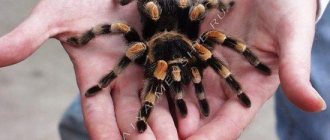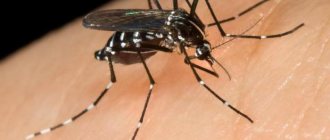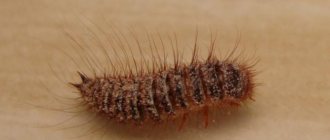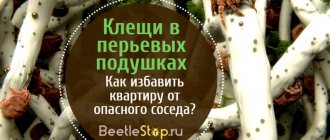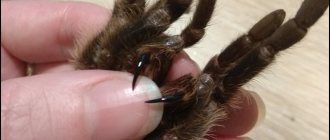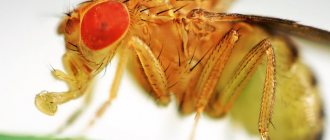06.11.2016
Spiders appear in almost every apartment from time to time. People's attitude towards these living beings is ambiguous: some do not like them and try to eliminate them, others, blaming folk superstitions, leave them alone. In order not to torment yourself with doubts about what to do with new neighbors, you need to know whether they are dangerous or, on the contrary, beneficial and how to prevent their appearance in the apartment.
- What species live in the apartment
- Reasons for appearing in the apartment
- Dangerous or not
Who is a spider: introduction
Spider.
Spiders are the eternal neighbors of people. Their role is often underestimated, considering them unpleasant creatures. But their role in nature is very great. There is a whole science, arachnology, that studies this type of animal.
Spiders are representatives of the Arthropod phylum, Arachnida class. Currently there are more than 42 tons of species and more than 1000 fossils.
There is a recognized disease - arachnophobia. Moreover, for the most part, people cannot explain the reason for their fear. Experts believe that it is associated with childhood trauma. Symptoms appear: headache, fainting, nausea and the desire to run.
Arachnophobia is one of the most common and difficult to treat diseases.
Spiders of Russia.
Matters of the heart
Spiders have males and females, but the males of this order have an unenviable fate: they are smaller in number, their life expectancy is much shorter, and even their body sizes are significantly smaller than the females.
During the mating season, gentlemen try in various ways to show that they are interested in procreation. Some bring gifts to the female, others perform certain tappings on the net, and still others perform ritual dances.
After mating, many species experience cannibalism, and if the “groom” is not particularly efficient, he can easily be eaten. This happens not because the females are excessively gluttonous, but because for the full development of the offspring, a lot of protein substances are needed, which are easiest and fastest to take from the future father.
An interesting fact concerns the fertility of these creatures: even a small female can lay up to 20 thousand eggs at a time, from which new representatives of the order will grow.
In certain species, for example, Stegodyphus dumicola, females care for their offspring together, raising a kind of nursery. Arachnologists know an interesting fact: after hatching, representatives of this species eat their mother, and they do this without attacking her: she herself invites them to the first meal with her body. In the arid regions where this species lives, such self-sacrifice is the only way to leave offspring behind.
Order Arthropods
Arthropods are a group that accounts for more than 80% of the planet's living creatures. Their difference is an exoskeleton made of chitin and paired jointed limbs.
The ancestors of arthropods are considered to be either worm-like or tracheal. However, there is an opinion that all representatives came from one ancestor - nematodes.
Representatives of arthropods.
One of the most famous classifications of origin divides them into three types:
- Tracheal;
- Crustaceans;
- Cheliceraceae.
Tracheal
This group of arthropods have respiratory organs, which made them adapted to life on land. The respiratory system has been improved, and the skin has been strengthened.
There are several representatives of this species.
A superclass of invertebrates that has a segmented body. They have a large number of legs and a body that is not divided into sections.
Centipedes
This is a subphylum that includes a wide variety of insects. According to the name, the number of their limbs is six. Lifestyle and nutrition are different.
Hexapods
Crustaceans
This group contains a large number of animals that live in various types of reservoirs. Although there are some species that can live on land or in humid conditions.
They have a chitinous exoskeleton that is periodically shed and their respiratory organs are gills. The group includes:
- crabs;
- lobsters;
- shrimps;
- crayfish;
- krill;
- lobsters.
Cheliceraceae
Cheliceraceae.
The largest part of this subgroup is represented by arachnids. These also include ticks and crustacean scorpions. They have a specific role in nature and for humans.
The subclass got its name from its limbs, chelicerae. These are oral appendages that are divided into two or three segments. But they are not designed for eating tough foods.
Magic material
The most recognizable and characteristic feature of the squad is the web. This material is truly unique: all attempts to artificially restore it in the laboratory have not yet been successful. The persistence of scientists in this matter can be understood, since the strength and elasticity of this material is unique: with a web, comparable in thickness to a simple pencil, you can stop a Boeing at full speed and throw it back, like the rubber band of a slingshot.
The web is a liquid secreted from the arachnoid glands, which hardens immediately after contact with air. In composition it is pure protein. Interestingly, most of the nets that are a little worn out are eaten by the builders themselves, so that the protein does not go to waste. They do not touch the main thick thread, but on the basis of it they again weave a new network.
Many people are interested in how the paws of the predators themselves, weaving the webs, do not stick to the web? For this purpose, there are special hairs that reduce the density of touch. In addition, there is a substance on the hairs that repels drops of glue on the web.
Thanks to the web, used as a parachute, arachnids are able to fly over long distances, and some representatives are able to swim on the surface of the water.
Insects and spiders
These two types of arthropods are often confused. But they have much more differences than they have in common. Among insects, there are those that eat meat and those that are vegetarians. Spiders are mostly predators.
Spiders are definitely not insects! More differences in the structure and behavior of insects and spiders in the article at the link.
Spider Anatomy
Spider eyes
The number of eyes is not an indicator of good vision. And spiders are a prime example of this.
Spider legs
The limbs perform not only a walking role. They help in hunting.
Spider Reproduction
The method of reproduction of spiders is determined by their lifestyle and structural features.
How to get rid of it?
The fight against unpleasant neighbors in the house must begin with mechanical capture or destruction of arthropods.
mosquito net
What to do next:
- Spiders must be prevented from entering housing. To do this, the windows should be covered with mosquito nets (at the same time flies and mosquitoes will not fly in);
- Seal cracks and holes (putty, fill with foam);
- Get rid of pests to deprive spiders of food. Mosquito nets will come in handy;
- Cover the ventilation grilles with fine mesh (at the same time cockroaches will not get in);
- Carry out a thorough cleaning, sort out heaps of rubbish in closets, basements, and on the balcony;
- Eliminate leaks and dry all rooms.
To get rid of spiders, you can use folk remedies:
- Boric acid is poisonous to all living beings, including arthropods. 1 tbsp. l. The powder should be diluted in 1 liter of clean water, and the solution should be used to wipe the corners and surfaces where spiders were noticed. When using, you should take precautions, do not apply treatment near pets, children, and remove food products.
- Essential oils of mint, tea tree, eucalyptus, and citrus fruits (lemon, orange, grapefruit) perfectly repel arthropods. Dilute 15 drops in 1 liter of water. Spray the spiders' habitats with the resulting aromatic liquid.
- the chestnut fruits and scatter them on the floor, under furniture, in the bathroom, pantry, behind baseboards.
- Diatomite (other names: keselkur, mountain earth) is a sedimentary rock with a high concentration of silicon; it is not dangerous for humans and domestic animals. The abrasive powder is used in the same way as crushed chestnuts (see above).
- Table vinegar (9%) is sprayed onto spider nests.
Ready-made chemicals for fighting spiders are available in a wide range.
- An aqueous solution of the drug “Butox 50” (30 ml per 10 liters of water) is sprayed onto the masonry site. After 20 minutes, the area is washed with a large amount of soap solution.
- Dobrokhim Phos is used similarly, dosage 10 ml per 1 liter. water.
- An insecticidal pencil (crayon) is also harmful to spiders.
- Sprays such as “Dichlorvos” and “Raid” are sprayed in the habitats of spiders, then the room is ventilated.
- Trap tablets attract spiders with their scent. After some time, the animals die.
- A relatively new way to combat spiders is aquafumigators. Within 10-12 hours, all flying and crawling insects, spiders, bedbugs, etc. die in the room.
What types of spiders are there?
Large pink tarantula.
There are more than 40 thousand species of spiders. They can live in grass, near human habitation and in remote places.
There are very miniature spiders, but there are also large representatives that do not fit on a plate. But all species have the same structure.
Conventionally, types of spiders can be divided into:
- woody;
- domestic;
- safe;
- poisonous.
In Russia, according to the latest data, there are about 2,400 species. More and more of them are opened every year. They are distributed in different regions and climates.
A detailed acquaintance with the spider fauna of Russia.
I
Spider venom in individual species consists of completely different substances, which have different effects on the body. After the bites of some representatives, a person begins to sweat, after others, a severe fever begins, after others, heart failure is observed, after fourths, terrible pain is felt in the bitten limb.
It should be noted that there are hundreds of times fewer poisonous representatives than our imagination imagines. But some of them can actually cause harm to health or lead to death. The most dangerous is the aggressive soldier spider, which moves at high speed. It lives in Brazil, where it often climbs into people's houses and attacks anyone who approaches. An adult man can escape with severe pain and fever, but a child or elderly person dies after being bitten.
No less dangerous in this regard is the tarantula, whose life lasts about 30 years. He will never be the first to attack a person, but if he sees a threat in the actions, he can use poison as self-defense. Most people believe that tarantulas are deadly, but this fact is not fair. The bite is indeed very painful and causes severe inflammation, but does not pose a threat to human life.
Interesting Facts
Spiders inspire fear in people, but at the same time they inspire interest. Therefore, they are studied and even raised at home as pets.
Flying spiders
There is evidence that some species of spiders can fly. And this is not to instill fear in the impressionable. This method is a protection and a method of movement.
Spiders with a tail
There were individuals that had a tail. Unusual tailed spiders and their descendants.
Web
Spider web is a strong and stable material; it can stretch several times and return to its original position.
Birth of spiderlings
How are spiders born? Let's start with how the baby develops. The spider lies in the egg, right on the yolk of the egg. And it comes together in one heap. Before this it was segmented. And then all his body parts—segments—merged together. And the spider began to resemble a normal arthropod creature: there was an abdomen, eight legs, and a head, gradually turning into a chest, with eight eyes.
Our baby has grown up. The egg is cramped for him. This is where the shell of the egg bursts. Or the spider itself makes its way to the exit, breaking the shell. If the mother is alive and nearby, she will help the offspring get out. If not, then the little ones should sit in the remains of the shell and wait for the first molt. Little spiders are funny: they are hairless and colorless. They cannot eat or weave webs on their own.
